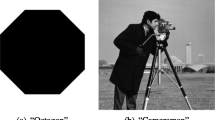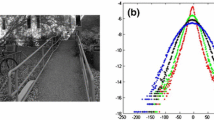Abstract
This paper presents a novel approach to image sharpness assessment designed primarily for facial images. The approach can be described as holistic analysis of the frequency–amplitude spectrum by means of fitting an approximation model and obtaining the estimate based on the model’s parameters. The proposed method shows better correlation with perceived sharpness than other existing methods both on synthetic tests and on a set of real-world face images. We demonstrate an application of the resulting estimate to enhance the accuracy of a face gender classifier.








Similar content being viewed by others
References
Ferzli, R., Karam, L.J.: A no-reference objective image sharpness metric based on the notion of just noticeable blur (JNB). IEEE Trans. Image Process. 18(4), 717–728 (2009)
Gaidhane, V.H., Hote, Y.V., Singh, V.: Image focus measure based on polynomial coefficients and spectral radius. SIViP 9(1), 203–211 (2015)
Manap, R., Shao, L.: Non-distortion-specific no-reference image quality assessment: a survey. Inf. Sci. 301, 141–160 (2015)
Minin, P., Mikhaylov, D.: Analysis of gender recognition methods’ robustness. In: Proceedings of Fifth International Conference on Intelligent Control and Information Processing, Dalian (2014)
Batten, C.F.: Autofocusing and Astigmatism Correction in the Scanning Electron Microscope (2000)
Crété-Roffet, F., Dolmiere, T., Ladret, P., Nicolas, M.: The blur effect: perception and estimation with a new no-reference perceptual blur metric. In: SPIE Electronic Imaging Symposium Conference on Human Vision and Electronic Imaging, San Jose, USA (2007)
Gu, K., Zhai, G., Lin, W., Yang, X., Zhang, W.: No-reference image sharpness assessment in autoregressive parameter space. IEEE Trans. Image Process. 24(10), 3218–3231 (2015)
Bahrami, K., Kot, A.: A fast approach for no-reference image sharpness assessment based on maximum local variation. IEEE Signal Process. Lett. 21(6), 751–755 (2014)
Zhu, X., Milanfar, P.: A no-reference sharpness metric sensitive to blur and noise. In: International Workshop on Quality of Multimedia Experience, 2009. QoMEx 2009 (2009)
Abdalmajeed, S., Shuhong, J.: Using the natural scenes’ edges for assessing image quality blindly and efficiently. Math. Probl. Eng. 2015, 9 (2015). doi:10.1155/2015/389504
Li, L., Lin, W., Wang, X., Yang, G., Bahrami, K., Kot, A.: No-reference image blur assessment based on discrete orthogonal moments. IEEE Trans. Cybern. 46(1), 39–50 (2016)
Kang, L., Ye, P., Li, Y., Doermann, D.: Convolutional Neural Networks for No-Reference Image Quality Assessment. In: Proceedings of the IEEE Conference on Computer Vision and Pattern Recognition, pp. 1733–1740 (2014)
Marziliano, P., Dufaux, F., Winkler, S., Ebrahimi, T.: A no-reference perceptual blur metric. In: Proceedings of the International Conference on Image Processing, Rochester, NY (2002)
Guan, J., Zhang, W., Gu, J., Ren, H.: No-reference blur assessment based on edge modeling. J. Vis. Commun. Image Represent. 29, 1–7 (2015)
De, K., Masilamani, V.: Image sharpness measure for blurred images in frequency domain. Procedia Eng. 64, 149–158 (2013)
Cohen, E., Yitzhaky, Y.: No-reference assessment of blur and noise impacts on image quality. Signal Image Video Process. 4(3), 289–302 (2010)
Vu, C.T., Phan, T.D., Chandler, D.M.: S3: a spectral and spatial measure of local perceived sharpness in natural images. IEEE Trans. Image Process. 21(3), 934–945 (2012)
Ciancio, A., da Costa, A.T., da Silva, E.A., Said, A., Samadani, R., Obrador, P.: No-reference blur assessment of digital pictures based on multifeature classifiers. IEEE Trans. Image Process. 20(1), 64–75 (2011)
Harris, F.J.: On the use of windows for harmonic analysis with the discrete Fourier transform. Proc. IEEE 66(1), 51–83 (1978)
Field, D.J., Brady, N.: Visual sensitivity, blur and the sources of variability in the amplitude spectra of natural scenes. Vis. Res. 37(23), 3367–3383 (1997)
Sheikh, H.R., Sabir, M.F., Bovik, A.C.: A statistical evaluation of recent full reference image quality assessment algorithms. IEEE Trans. Image Process. 15(11), 3440–3451 (2006)
Jones, E., Oliphant, T., Peterson, P., et al.: SciPy: Open source scientific tools for Python. http://www.scipy.org/ (2001). Accessed 16 June 2016
Storn, R., Price, K.: Differential evolution-a simple and efficient heuristic for global optimization over continuous spaces. J. Glob. Optim. 11(4), 341–359 (1997)
Nordstrøm, M.M., Larsen, M., Sierakowski, J., Stegmann, M.B.: The IMM Face Database—An Annotated Dataset of 240 Face Images. Informatics and Mathematical Modelling, Technical University of Denmark, DTU (2004)
Huang, G.B., Mattar, M., Berg, T., Learned-Miller, E.: Labeled faces in the wild: a database for studying face recognition in unconstrained environments. In: Workshop on Faces in ’Real-Life’ Images: Detection, Alignment, and Recognition (2008)
Cortes, C., Vapnik, V.: Support-vector networks. Mach. Learn. 20, 273–297 (1995)
Pinto, N., Cox, D.D., DiCarlo, J.J.: Why is real-world visual object recognition hard? PLoS Comput. Biol. 4, e27 (2008)
Shan, C.: Learning local binary patterns for gender classification on real-world face images. Pattern Recogn. Lett. 33, 431–437 (2012)
Wolf, L., Hassner, T., Taigman, Y.: Descriptor based methods in thewild. In: Workshop on Faces in “Real-Life” Images: Detection, Alignment, and Recognition (2008)
Turk, M., Pentland, A.: Eigenfaces for recognition. J.Cogn. Neurosci. 3, 71–86 (1991)
Fiche, C., Ladret, P., Vu, N.-S.: Blurred face recognition algorithm guided by a no-reference blur metric. In: IS&T/SPIE Electronic Imaging (2010)
Author information
Authors and Affiliations
Corresponding author
Electronic supplementary material
Below is the link to the electronic supplementary material.
Rights and permissions
About this article
Cite this article
Minin, P., Shumilov, Y. Sharpness estimation in facial images by spectrum approximation. SIViP 11, 163–170 (2017). https://doi.org/10.1007/s11760-016-0915-4
Received:
Revised:
Accepted:
Published:
Issue Date:
DOI: https://doi.org/10.1007/s11760-016-0915-4




